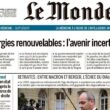Sixteen years after Apple’s iTunes store first enabled users to buy the song they wanted and not the whole album, magazine and newspaper publishers have not learned the lessons. Most continue to offer the same ‘package’ in digital as in print. They just don’t want to do anything that risks accelerating the decline of still-profitable print. But you can believe that the refusal to ‘unbundle’ newspapers in their digital versions is yet another reason why millennials stay away: They don’t want the whole package, so they don’t buy any of it.
Even those who would be attracted to specific content like sports, business or the arts, can be deterred by a digital package that’s as dominated by general news as it has always been in print, even though much of it is now freely available online. The UK launch of Tortoise by former BBC and News Corp executives underlined the possible challenge of a service which aims to compete just with the “op-ed” pages of quality newspapers. This month’s revelations of the impending ‘invasion’ of English Premier League football by the paid-for digital The Athletic emphasises the vulnerability of UK dailies, even in areas where they do have high-quality exclusive content. If they won’t give readers the option of buying their favourite content separately, someone else will.
That is the significance of the fact that the New York Times daily crossword now has 500,000 standalone subscribers paying $6.95 per month. The app is now the fifth largest digital subscription product from a US news provider. With a similar Cooking app (said to have more than 200,000 subscribers) and the recent launch of Parenting, these initiatives represent a major strategy by the New York Times which sees them as entry products: since they are priced at less than half of the newspaper itself, they have tended to boost subscriptions for the complete package (whether in print or digital).
The apps are part of the New York Times recovery. But digital revenue is still only 38% of the company which remains dependent on its high-priced print subscriptions bought by ageing readers. So, even the brilliant Crossword app is still so much about the newspaper. The New York Times is not much closer (yet) than any other newspaper to offering the “pick and mix” digital subscriptions that iTunes followers might expect.
But the success so far should prompt daily news brands to realise that such “vertical” slices of content should increasingly be viewed as commercial opportunities to build even larger specialist audiences through deeper content, membership events, and e-commerce – and not just as ways to sell newspaper subscriptions.
Once daily papers start to view these as specialist media ‘channels’ in their own right, it will only be a short step to building new brands that will attract audiences beyond the reach of the newspaper itself. Perhaps they should look at partnering with (or acquiring) specialist magazines, in order to deepen digital content and audiences. From boats to baking and crafts to computing, magazines could help newspapers to build strong specialist verticals. The New York Times’ collaboration with Meredith on magazine specials this year (e.g. “Summer of ’69”) may even get them thinking.
The internet encourages specialisation. Readers, especially digital natives, are increasingly prepared to pay only for exclusive information – and only for the stuff they actually want. You suspect that even the genuinely exclusive content of daily newsbrands is being under-valued and under-recognised because it is only available as part of an indivisible package much of which is unwanted (or, at least, under-valued) by prospective readers.
Newspaper co-branded digital ‘magazines’ could benefit from relatively low content costs, established brands, and the promotional power and subscription skills of many daily papers. Magazines and newspapers could even save each other. What are you waiting for?




